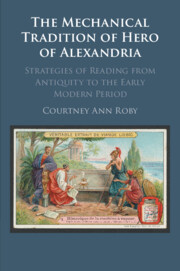Refine search
Actions for selected content:
13583 results in History of science and technology
Chapter 4 - Hero in Context
-
- Book:
- The Mechanical Tradition of Hero of Alexandria
- Published online:
- 06 July 2023
- Print publication:
- 20 July 2023, pp 140-207
-
- Chapter
- Export citation
Chapter 1 - Introduction
-
- Book:
- The Mechanical Tradition of Hero of Alexandria
- Published online:
- 06 July 2023
- Print publication:
- 20 July 2023, pp 1-19
-
- Chapter
- Export citation
Acknowledgments
-
- Book:
- The Mechanical Tradition of Hero of Alexandria
- Published online:
- 06 July 2023
- Print publication:
- 20 July 2023, pp viii-viii
-
- Chapter
- Export citation
Chapter 3 - Theorizing the World
-
- Book:
- The Mechanical Tradition of Hero of Alexandria
- Published online:
- 06 July 2023
- Print publication:
- 20 July 2023, pp 74-139
-
- Chapter
- Export citation
Chapter 2 - Systems of Explanation
-
- Book:
- The Mechanical Tradition of Hero of Alexandria
- Published online:
- 06 July 2023
- Print publication:
- 20 July 2023, pp 20-73
-
- Chapter
- Export citation
Presidential Address ‘Some years of cudgelling my brains about the nature and function of science museums’: Frank Sherwood Taylor and the public role of the history of science
-
- Journal:
- The British Journal for the History of Science / Volume 56 / Issue 3 / September 2023
- Published online by Cambridge University Press:
- 12 July 2023, pp. 283-307
- Print publication:
- September 2023
-
- Article
-
- You have access
- Open access
- HTML
- Export citation

The Mechanical Tradition of Hero of Alexandria
-
- Published online:
- 06 July 2023
- Print publication:
- 20 July 2023
Introduction: Power to the image! Science, technology and visual diplomacy
-
- Journal:
- The British Journal for the History of Science / Volume 56 / Issue 2 / June 2023
- Published online by Cambridge University Press:
- 23 June 2023, pp. 135-146
- Print publication:
- June 2023
-
- Article
-
- You have access
- Open access
- HTML
- Export citation
9 - Divinatory Science in the City and the Bush
-
- Book:
- Science and Power in the Nineteenth-Century Tasman World
- Published online:
- 18 May 2023
- Print publication:
- 01 June 2023, pp 206-227
-
- Chapter
- Export citation
SIC volume 36 issue 2 Cover and Back matter
-
- Journal:
- Science in Context / Volume 36 / Issue 2 / June 2023
- Published online by Cambridge University Press:
- 02 September 2025, pp. b1-b2
- Print publication:
- June 2023
-
- Article
-
- You have access
- Export citation
A Note on Language
-
- Book:
- Science and Power in the Nineteenth-Century Tasman World
- Published online:
- 18 May 2023
- Print publication:
- 01 June 2023, pp xv-xv
-
- Chapter
- Export citation
Bibliography
-
- Book:
- Science and Power in the Nineteenth-Century Tasman World
- Published online:
- 18 May 2023
- Print publication:
- 01 June 2023, pp 234-262
-
- Chapter
- Export citation
Of pashas, popes, and indivisibles
- Part of
-
- Journal:
- Science in Context / Volume 36 / Issue 2 / June 2023
- Published online by Cambridge University Press:
- 11 June 2025, pp. 123-146
- Print publication:
- June 2023
-
- Article
-
- You have access
- Open access
- HTML
- Export citation
Introduction: The Show Begins
-
- Book:
- Science and Power in the Nineteenth-Century Tasman World
- Published online:
- 18 May 2023
- Print publication:
- 01 June 2023, pp 1-30
-
- Chapter
- Export citation
6 - Black Phrenologists, Black Masks
-
- Book:
- Science and Power in the Nineteenth-Century Tasman World
- Published online:
- 18 May 2023
- Print publication:
- 01 June 2023, pp 148-167
-
- Chapter
- Export citation
Jacqueline Mitton and Simon Mitton, Vera Rubin: A Life Cambridge, MA: Belknap Press, 2021. Pp. x + 309. ISBN 978-0-6749-1919-8. £23.95 (hardback).
-
- Journal:
- The British Journal for the History of Science / Volume 56 / Issue 2 / June 2023
- Published online by Cambridge University Press:
- 07 June 2023, pp. 278-279
- Print publication:
- June 2023
-
- Article
- Export citation
Paula De Vos, Compound Remedies: Galenic Pharmacy from the Ancient Mediterranean to New Spain Pittsburgh: University of Pittsburgh Press, 2021. Pp. 404. ISBN 978-0-8229-4649-6 $50.00 (hardback).
-
- Journal:
- The British Journal for the History of Science / Volume 56 / Issue 2 / June 2023
- Published online by Cambridge University Press:
- 07 June 2023, pp. 275-276
- Print publication:
- June 2023
-
- Article
- Export citation
maps
-
- Book:
- Science and Power in the Nineteenth-Century Tasman World
- Published online:
- 18 May 2023
- Print publication:
- 01 June 2023, pp xvii-xviii
-
- Chapter
- Export citation
Acknowledgements
-
- Book:
- Science and Power in the Nineteenth-Century Tasman World
- Published online:
- 18 May 2023
- Print publication:
- 01 June 2023, pp xii-xiv
-
- Chapter
- Export citation
Epilogue
-
- Book:
- Science and Power in the Nineteenth-Century Tasman World
- Published online:
- 18 May 2023
- Print publication:
- 01 June 2023, pp 228-233
-
- Chapter
- Export citation
